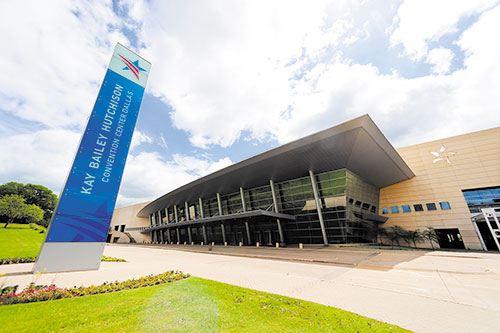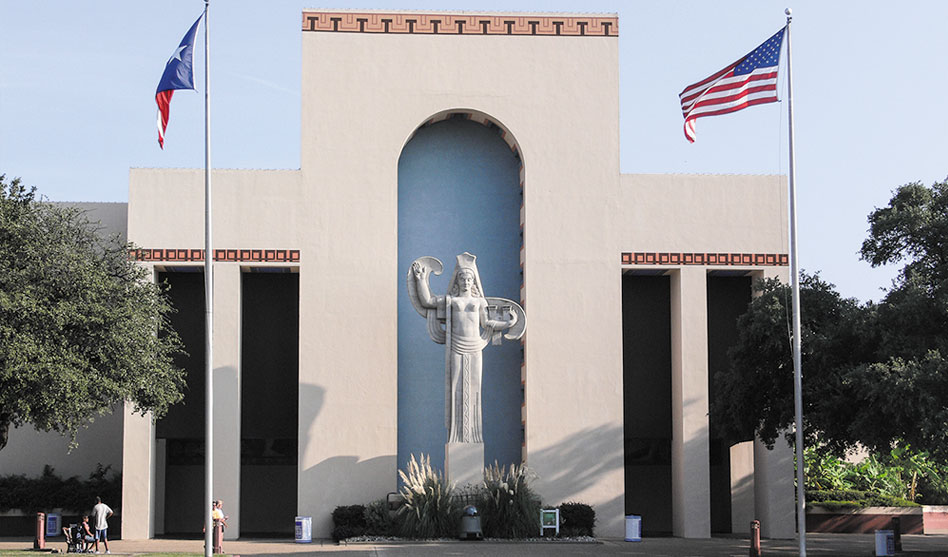The Centennial Building at Fair Park is on the list for upgrades if voters approve Prop A.
(Photo by Andreas Praefcke)
Prop A would fix 6 Fair Park facilities and replace a broken convention center
DAVID TAFFET | Senior Staff Writer
taffet@dallasvoice.com
The last item on the ballot for city of Dallas voters in the Nov. 8 midterm election will be Proposition A, a ballot measure proposing funding for upgrades to six buildings in Fair Park and replacement of most of Dallas’ Kay Bailey Hutchison Convention Center.
The improvements would be paid for by a 2 percent increase in the hotel occupancy tax at hotels within the city of Dallas. Such funding is allowed under what’s known as the Brimer Bill, used by the city just once before, in 1999, when Dallas voters approved a 2 percent increase in hotel and rental car taxes to build the American Airlines Center.
Revenue was much higher than expected in that instance, and the 30-year bonds that were issued to pay for construction of the AAC were paid off in 15 years.
The Brimer Bill allows cities to use the two taxes on visitors to pay for bonds issued to build sports arenas, convention centers and entertainment districts. In the last session of the Legislature, state Rep. Rafael Anchia filed a bill extending the law to cover municipal park systems. State Sen. Royce West filed the companion bill.
AT FAIR PARK
Of the $1.5 billion proposed in Prop A, 20 percent would go to six structures in Fair Park — The Cotton Bowl, the Coliseum, the Band Shell, the Automobile Building, the Centennial Building and the Music Hall.
The Cotton Bowl needs new locker rooms, and luxury suites and club seats would be added, the press box moved and structural issues addressed.
The Coliseum, tucked behind the Cotton Bowl, is probably the least-known building of those proposed for upgrades. Restrooms and concessions would be added. And one of the biggest problems with the building, the fact that you can’t get from one side to the other without going outside, would be fixed with new construction.
During the pandemic, the Turtle Creek Chorale performed in the building. Live Nation took notice and will book more concerts in the facility once improvements are made. Women’s professional volleyball is played in the building, and more sports programming — including rodeos — could come if the Coliseum is upgraded.
The Band Shell is used for virtually nothing other than a bird show during the State Fair. A shade canopy will make the facility more attractive to audiences, and renovated backstage dressing rooms will make it friendlier to performers. It was the original home of Dallas Summer Musicals, but little has been done to upgrade 4,000-seat facility since it was built in 1936.
Dallas Pride had planned to use the Band Shell for two shows in June 2021 when the annual Pride celebration had to be reworked to accommodate pandemic precautions. But the threat of impending severe storms prompted organizers to move the shows from outdoors at the Band Shell indoors to the Coliseum.
Architects are still working on plans, so the exact upgrades planned for the Centennial and Automotive buildings and the Music Hall are not available yet, said Veletta Lill, a former Dallas City Councilwoman who represented Oak Lawn. She serves on the board of Fair Park First, which raises money for the park and promotes Fair Park’s usage.
Lill said the Music Hall alone has $90 million in needs, but all of those needs can’t be addressed in this round of improvements. Bond money would be used “to improve the artistic integrity of the hall,” she said.
The two exhibition buildings have drainage and roof issues that would be addressed along with other structural problems. And part of the work there would include preservation of the buildings’ frescos.
“All the money earned at the park returns to the park,” Lill said. “The State Fair contributes excess revenues to maintain some of the buildings.”
In 2021, Fair Park became a Texas cultural district, and, with that designation, the park is entitled to Texas Commission for the Arts money, Lill said. Its national landmark status entitles Fair Park to federal tax credits that can be sold to private businesses to redo historic buildings.
The $300 million from Proposition A that would go toward these facilities should bring quite a bit more revenue into the park, and that revenue would then be used to upgrade and maintain other buildings there along with the other creative methods of funding Lill described.

Dallas Convention Center (AP Photo/Tony Gutierrez)
THE CONVENTION CENTER
Then there’s downtown’s convention center — a building in need of about half a billion dollars’ worth of repairs. When it rains, leaks are so bad the water has to be caught by a system of “diapers” that have been installed in the building. The city spends $1 million every year just trying to keep convention-goers from getting wet.
The problem with the center is that one piece after another was tacked onto the building to create an inadequate, confusing and barely usable space. And despite all the add-ons, the convention center still lacks adequate ballroom, exhibit and meeting areas. Tearing down most of the building and replacing it makes the most sense, Lill suggested.
VisitDallas says the city has to turn away some conventions because of the configuration that doesn’t allow the city to host two conventions at once.

Veletta Lill
Plans have not been finalized for the convention center redo, either. Construction wouldn’t begin until 2024, but the general plan is to align it along Lamar Street with a deck park extending over I-30.
The original 1956 George Dahl-designed portion of the convention center, now The Black Academy of Arts and Letters, would be saved. The rest of the building would be replaced.
Lill said she understood the plan is to tear down the building piecemeal to continue hosting conventions with as little disruption as possible. The new convention center would be more efficient and customer-friendly and become the anchor of a new downtown entertainment district.
And if it is designed properly, Dallas would be able to host more conventions that will attract more visitors and bring in more revenue.
A “YES” vote on Proposition A is a vote FOR issuing $1.5 billion in bonds. A “NO” vote on Proposition A is a vote AGAINST issuing $1.5 billion in bonds

